(Original post March 6, 2017; updated 2020)
These two houses, 38 Hicks Street and 40 Hicks Street, built very close in time together around 1810, are the oldest houses still standing on Brooklyn Heights.
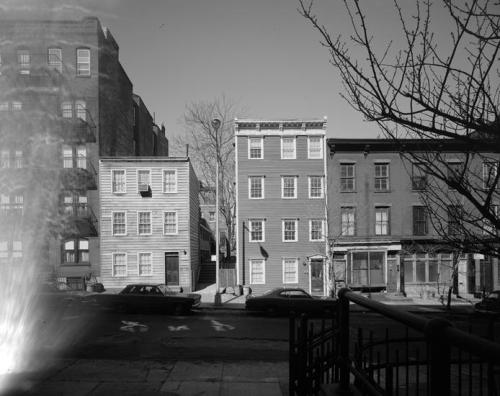
The full range of available source data I’ve researched all point to the 1810 date, which is backed up with earlier, partial research done by the Landmarks Preservation Commission and the Brooklyn Historical Society. The case for 1810 is as convincing as you’ll ever see for a 200-year-old-plus Brooklyn home. While Clay Lancaster’s belief that the houses dated to 1830 has been widely cited, it turns out that he didn’t review all of the data. (And as a result, his “Joseph Bennett House” moniker for 38 Hicks Street is arbitrary…the “Van Cleef House” name would be more accurate, if you’re the type who thinks a vernacular clapboard house needs a name!)
As for the claim that these are the “oldest houses still standing on Brooklyn Heights” — I don’t give credit to the myths and rumors that some other houses in the neighborhood were built elsewhere in the 1700s and moved up to the Heights later. There’s no evidence at all that this happened to 24 Middagh Street, for example — it was almost certainly built around 1820. The case for 13 Pineapple Street is a little less cut-and-dry, but the most likely date for that house is the early 1820s.
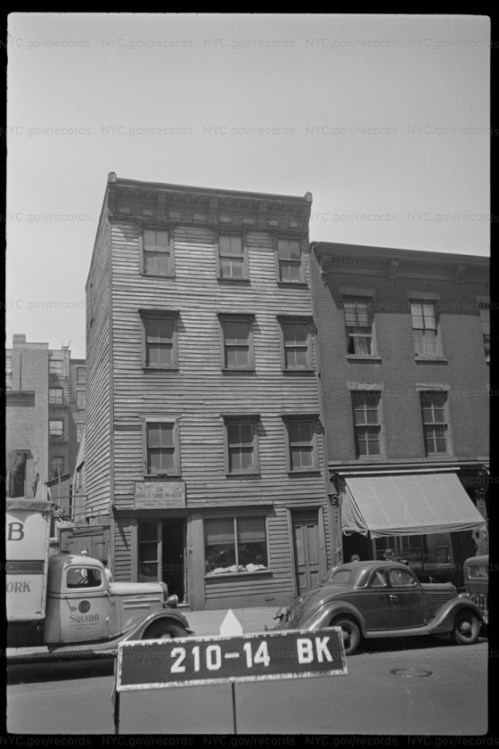
38 Hicks Street around 1940 (NYC Municipal Archives “tax photo”)
Peter Van Cleef bought the lot for today’s Number 38 from the Hicks brothers in 1810 and he appears living on Hicks Street in the Brooklyn section of Longworth’s 1811 New York directory (no house numbers were given). The same story applies to today’s Number 40, with Michael Vanderhoof as the owner.
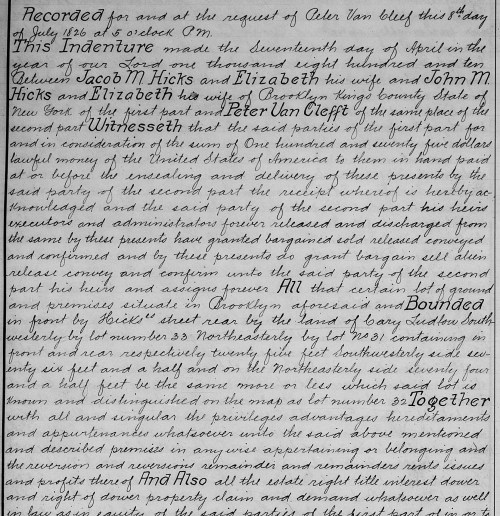
Recorded deed – Sale of lot 32 ($175!) from Jacob M. and Elizabeth Hicks & John M. and Elizabeth Hicks to “Peter Van Clefft” dated April 17, 1810 (recorded by Peter Van Cleef July 8, 1826). See 1806 map below for diagram of numbered lots.
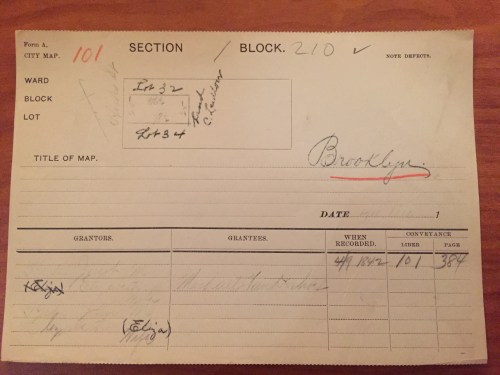
Abstract of deed – Sale of lot 33 from Hicks to Michael Van Derhoef dated April 18, 1810 (recorded April 9, 1842)
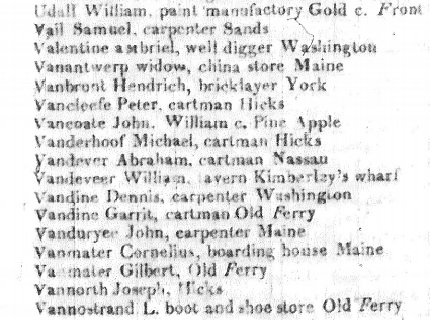
Vancleefe and Vanderhoof in Longworth’s 1811 Directory
Both Michael Vanderhoof and a Leah V Cleef appear in the 1810 census living at the properties. (Although no addresses are given, they’re situated in the census list where one would expect for 38 Hicks and 40 Hicks based on the surrounding names which are correlated to the known lot owners. Another abstract of the census shows “M Van Cleef” instead of Leah Van Cleef.) Both Van Cleef and Vanderhoof continue to appear in the first village directory from 1822 and subsequent directories at these houses for some years.

1810 Census for Brooklyn in Kings County, showing Michael Vanderhoff and Leah V Cleef (widow)
Van Cleef (sometime written Van Cleefe) is described in the directories as a cartman; Vanderhoof (sometimes rendered Vanderhoef or Vanderhoff) as either a cartman or waterman. Van Cleef is probably related to the “sisters Van Cleef” who according to Stiles ran a shop down the hill on the Old Ferry Road; they’re described as the daughters of “Old Rulof Van Cleef, the ferryman.”
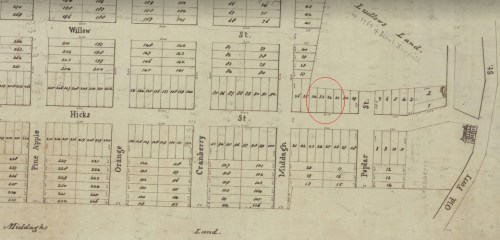
Map of the property of Jacob. M and John M. Hicks, 1806. Lots 32 and 33 circled — mid-block Hicks Street between Poplar and Middagh Streets. (Lot numbers not to be confused with the pre-1870 street addresses, when the homes were known as 32 Hicks and 34 Hicks.)
The two houses, together with their owners, might have been regarded by contemporaries as completely typical and without special note, but as the oldest surviving examples in Brooklyn (and probably all of New York City) of laboring-class residences, they’ve come into their own as a special pair.
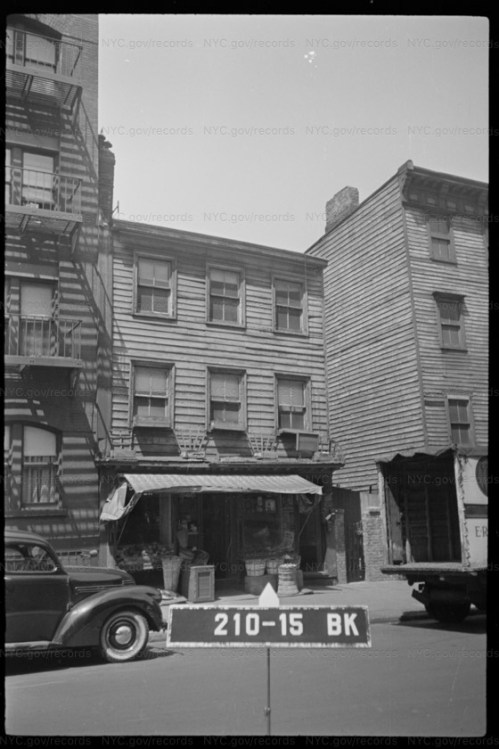
40 Hicks Street around 1940 (NYC Municipal Archives “tax photo”)
As was typical for the early 19th century in Brooklyn, each house was almost certainly built with a gabled roof, with the roof ridge parallel to the street. 38 Hicks would’ve been 3 stories plus attic, and 40 Hicks most likely just two stories tall plus attic. (Carefully examine Francis Guy’s “Winter Scene in Brooklyn, 1820” which accurately represents the houses and streets around the ferry landing – there’s not one flat-pitched roof in the bunch.) Given the shallow depth of each building, the roof would’ve been a single pitch and the attics were unlikely to have been tall enough to be suitable for anything other than storage (or, the interior ceiling of the top floor would be pitched without an attic).
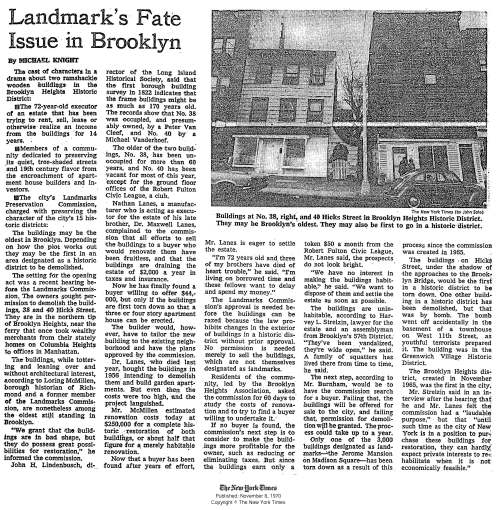
New York Times (November 8, 1970) – Landmark’s Fate Issue in Brooklyn. “Buildings at No. 38 and 40 Hicks Street….They may be Brooklyn’s oldest.” (Long Island Historical Society searched directories back to 1822, but not earlier documents.)
By the second half of the 19th century, “fire districts” outlawed the construction of new frame buildings across much of the city, but certain enlargements were still possible for grandfathered structures and it became fashionable to create an additional story by raising the pitched roof, eliminating the attics and creating buildings that have essentially flat roofs. Number 38 ended up at four stories and Number 40 with three. Evidence for these original gabled roofs has been found in many of the frame houses in the Heights that have undergone renovations. The heavy bracketed cornice on Number 38 is a typical late 19th century Italianate style, added after the roof was raised; the smaller dentiled cornice on Number 40 is more in keeping with the early 19th century facade but is no less of a later alteration than its neighbor’s cornice.
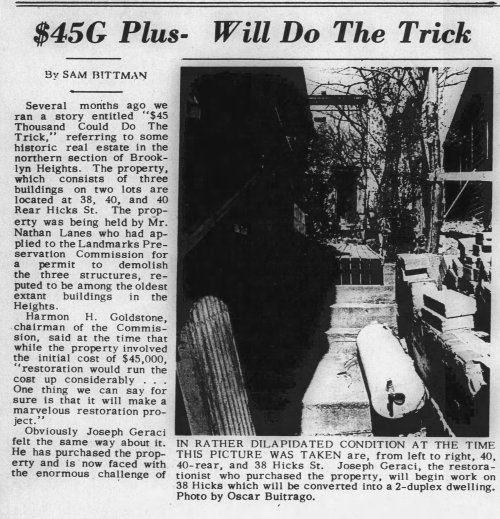
Brooklyn Heights Press (May 13, 1971). Research by the Landmarks Preservation Commission when approving the 1971 renovation corroborates the 1810 construction date.
40 Hicks Street presents a rare opportunity to peek through the front fence and look down the narrow alley between the two houses at the rear buildings on the lot. Many frame houses in the Heights had various rear sheds, workshops or back houses, sometimes attached at right angles like the frame rear house here (with its wooden porch), or sometimes detached (which is also present on this property in the form of the brick building). These rear-lot structures were accessed by side alleyways (such as is the case for Number 40) or sometimes by “horsewalks” – extremely narrow passages built right into the basement of the house allowing even a horse (supposedly) to walk directly from the street to stables or other rear-lot workshops. Side alleys were quite typical for the early Brooklyn Heights houses, especially the wood-frame ones, because the owners would often run their businesses (cooper shops, blacksmith shops, etc.) on the same property. But true horsewalk passages (as distinguished from side alleys) are rare on the Heights, being more associated with the Federal brick houses in Greenwich Village and other downtown areas of Manhattan.
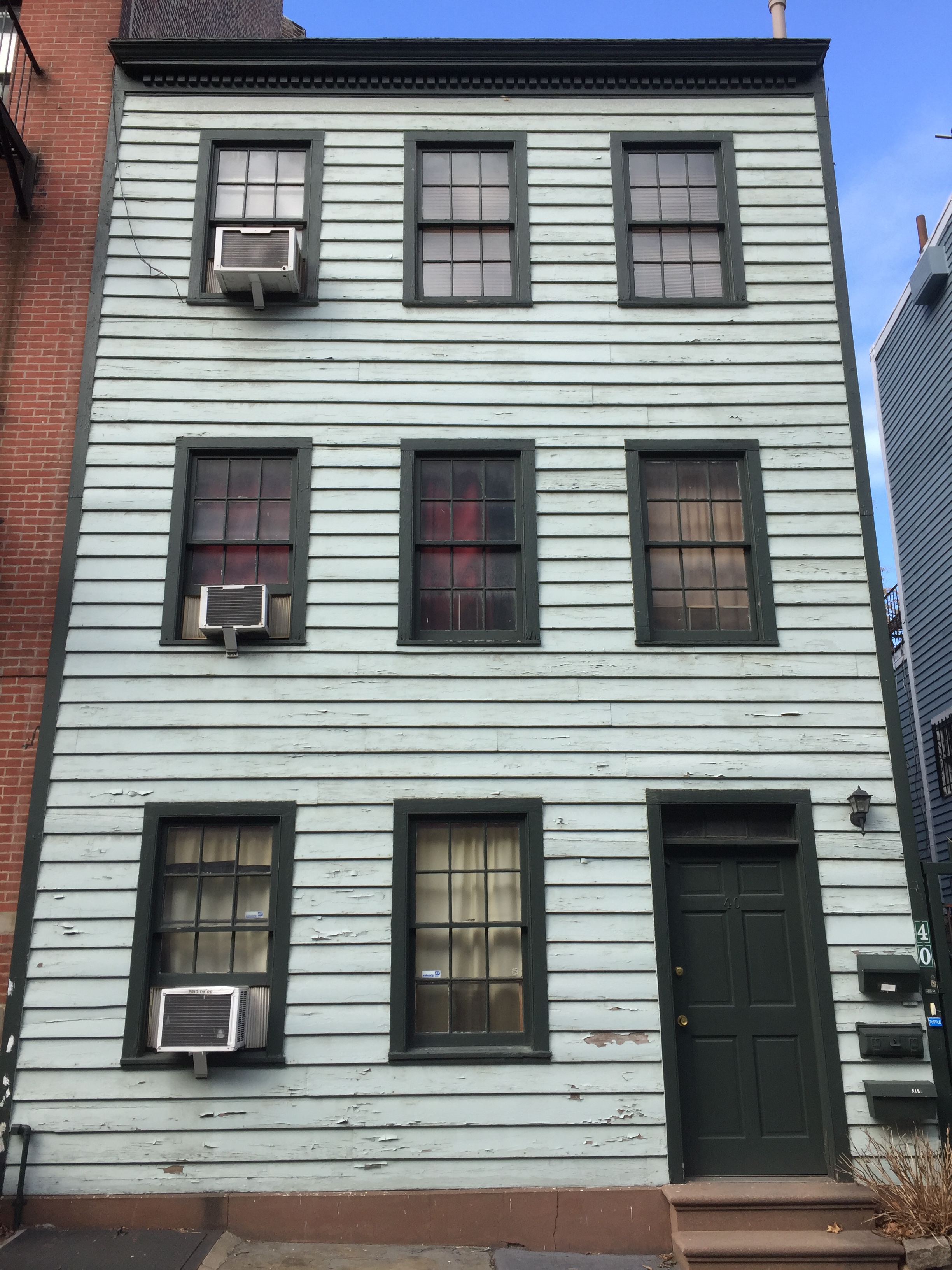
40 Hicks today

I am so appreciative of your blog! I found you as “JeremyL” in several comments on Brownstoner articles and was able track you down to this website. I work at P.S. 8 and since setting eyes on 38 Hicks knew it had to be special! I’m going to be doing walking tours in the summer and this information is invaluable. I too am most interested in the northern end of Brooklyn Heights. Thanks so much.
Glad you like it and that you found me! Will be in touch – have lots to share that I think you’ll find interesting.
I lived in the brick building at the rear in 1959 and 1960. It was called a studio. I paid 75 dollars a month to Mr. Lanes! It was pretty rough, but I loved it. I worked at the Metropolitan Museum art in the Library.
I find it fascinating to learn about these historical homes.